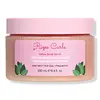What's inside
What's inside
 Key Ingredients
Key Ingredients

No key ingredients
 Benefits
Benefits

 Concerns
Concerns

 Ingredients Side-by-side
Ingredients Side-by-side

Water
Skin ConditioningAloe Barbadensis Leaf Juice
Skin ConditioningSodium C14-16 Olefin Sulfonate
CleansingCocamidopropyl Hydroxysultaine
CleansingHydrated Silica
AbrasiveSodium Cocoyl Isethionate
CleansingAcrylates Copolymer
Glycerin
HumectantSodium Gluconate
Skin ConditioningHydroxyacetophenone
AntioxidantGlycol Distearate
EmollientMoringa Oleifera Seed Oil
EmollientSodium Benzoate
MaskingPanthenol
Skin ConditioningArnica Montana Flower Extract
MaskingThymus Vulgaris Flower/Leaf Oil
MaskingMenthyl Lactate
MaskingMentha Piperita Oil
MaskingPelargonium Graveolens Oil
MaskingPhenoxyethanol
PreservativeEthylhexylglycerin
Skin ConditioningPolyquaternium-7
Montmorillonite
AbsorbentIllite
AbrasiveKaolin
AbrasiveCitric Acid
BufferingWater, Aloe Barbadensis Leaf Juice, Sodium C14-16 Olefin Sulfonate, Cocamidopropyl Hydroxysultaine, Hydrated Silica, Sodium Cocoyl Isethionate, Acrylates Copolymer, Glycerin, Sodium Gluconate, Hydroxyacetophenone, Glycol Distearate, Moringa Oleifera Seed Oil, Sodium Benzoate, Panthenol, Arnica Montana Flower Extract, Thymus Vulgaris Flower/Leaf Oil, Menthyl Lactate, Mentha Piperita Oil, Pelargonium Graveolens Oil, Phenoxyethanol, Ethylhexylglycerin, Polyquaternium-7, Montmorillonite, Illite, Kaolin, Citric Acid
Ingredients Explained
These ingredients are found in both products.
Ingredients higher up in an ingredient list are typically present in a larger amount.
Glycerin is already naturally found in your skin. It helps moisturize and protect your skin.
A study from 2016 found glycerin to be more effective as a humectant than AHAs and hyaluronic acid.
As a humectant, it helps the skin stay hydrated by pulling moisture to your skin. The low molecular weight of glycerin allows it to pull moisture into the deeper layers of your skin.
Hydrated skin improves your skin barrier; Your skin barrier helps protect against irritants and bacteria.
Glycerin has also been found to have antimicrobial and antiviral properties. Due to these properties, glycerin is often used in wound and burn treatments.
In cosmetics, glycerin is usually derived from plants such as soybean or palm. However, it can also be sourced from animals, such as tallow or animal fat.
This ingredient is organic, colorless, odorless, and non-toxic.
Glycerin is the name for this ingredient in American English. British English uses Glycerol/Glycerine.
Learn more about GlycerinSodium cocoyl isethionate is a natural ingredient from coconut oil. It is an ultra gentle cleanser that gives a nice foam without drying the skin or impacting the skin barrier.
The amount of foam created depends on the amount of sodium cocoyl isethionate used in the product.
This ingredient also helps improve the spreadability of a product.
Learn more about Sodium Cocoyl IsethionateWater. It's the most common cosmetic ingredient of all. You'll usually see it at the top of ingredient lists, meaning that it makes up the largest part of the product.
So why is it so popular? Water most often acts as a solvent - this means that it helps dissolve other ingredients into the formulation.
You'll also recognize water as that liquid we all need to stay alive. If you see this, drink a glass of water. Stay hydrated!
Learn more about Water